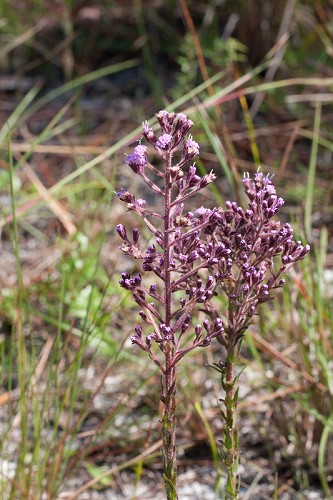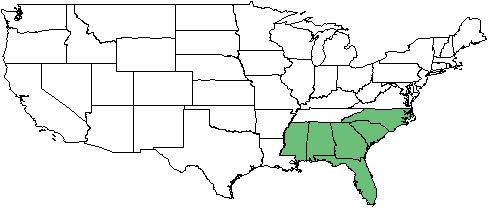Difference between revisions of "Trilisa paniculata"
(→Description) |
|||
| Line 36: | Line 36: | ||
<!--===Seed dispersal===--> | <!--===Seed dispersal===--> | ||
<!--===Seed bank and germination===--> | <!--===Seed bank and germination===--> | ||
| − | + | ||
| + | ===Fire ecology=== <!--Fire tolerance, fire dependence, adaptive fire responses--> | ||
| + | In Georgia cut over pine forests, percent coverage of ''T. paniculata'' decreases with the number of growing seasons since fire, from 0.8 after one season, to 0.2 after two and three seasons, and 0.1 after eight.<ref name="Lemon 1949">Lemon PC (1949) Successional responses of herbs in the longleaf-slash pine forest after fire. Ecology 30(2):135-145.</ref> | ||
<!--===Pollination===--> | <!--===Pollination===--> | ||
<!--===Use by animals===--> <!--Herbivory, granivory, insect hosting, etc.--> | <!--===Use by animals===--> <!--Herbivory, granivory, insect hosting, etc.--> | ||
Revision as of 13:37, 14 February 2018
| Trilisa paniculata | |
|---|---|

| |
| Photo by John Gwaltney hosted at Southeastern Flora.com | |
| Scientific classification | |
| Kingdom: | Plantae |
| Division: | Magnoliophyta - Flowering plants |
| Class: | Magnoliopsida - Dicots |
| Order: | Asterales |
| Family: | Asteraceae |
| Genus: | Trilisa |
| Species: | T. paniculata |
| Binomial name | |
| Trilisa paniculata (J.F. Gmel.) Herb. | |

| |
| Natural range of Trilisa paniculata from Weakley. [1] | |
Common Names: trilisa;[1] hairy chaffhead[2]
Contents
Taxonomic Notes
Synonym: Carphephorus paniculatus
Description
T. paniculata is a dioecious perennial forb/herb.[2]
Distribution
This species occurs from southeastern North Carolina, south to southern Florida, and westward to the Florida panhandle and southern Alabama.[1]
Ecology
Habitat
T. paniculata occurs in savannas and flatwoods.[1]
Phenology
In the southeastern and mid-Atlantic United States, flowering occurs from August through October and fruiting from September through November.[1]
Fire ecology
In Georgia cut over pine forests, percent coverage of T. paniculata decreases with the number of growing seasons since fire, from 0.8 after one season, to 0.2 after two and three seasons, and 0.1 after eight.[3]
Conservation and Management
Cultivation and restoration
Photo Gallery
References and notes
- ↑ 1.0 1.1 1.2 1.3 1.4 Weakley AS (2015) Flora of the Southern and Mid-Atlantic States. Chapel Hill, NC: University of North Carolina Herbarium.
- ↑ 2.0 2.1 USDA NRCS (2016) The PLANTS Database (http://plants.usda.gov, 14 February 2018). National Plant Data Team, Greensboro, NC 27401-4901 USA.
- ↑ Lemon PC (1949) Successional responses of herbs in the longleaf-slash pine forest after fire. Ecology 30(2):135-145.